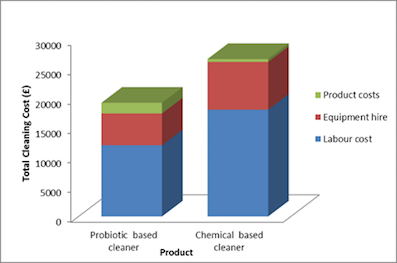 Cleanzine: your weekly cleaning and hygiene industry newsletter 18th April 2024 Issue no. 1110
Cleanzine: your weekly cleaning and hygiene industry newsletter 18th April 2024 Issue no. 1110
Your industry news - first
The original and best - for over 20 years!
We strongly recommend viewing Cleanzine full size in your web browser. Click our masthead above to visit our website version.
Are companies measuring the cost of cleaning correctly? Why false economies could be costing your business...
 Dr Emma Saunders, general manager at Genesis Biosciences, argues that biological cleaners can be a cost-effective alternative to traditional chemicals for the facilities management industry, when the 'bigger picture' is taken into account.
Dr Emma Saunders, general manager at Genesis Biosciences, argues that biological cleaners can be a cost-effective alternative to traditional chemicals for the facilities management industry, when the 'bigger picture' is taken into account.
"In the debate between traditional chemical and biological cleaners, product cost per litre or per case is often a decisive factor when choosing between the two. Biological cleaners tend to be more expensive on a per litre basis partly due to higher raw material costs and partly because the producers are often smaller companies that do not enjoy the same economies of scale as the mainstream producers.
To many in the facilities management industry, biological cleaners appear to deliver poor value compared to their chemical counterparts. But are companies measuring the costs of cleaning correctly? It's an important question, especially for cleaning contractors on slim margins who are tasked with purchasing the cleaning products and applying them.
In short, a good biological cleaner contains active bacteria, in spore form, which support or augment the cleaning action the product is trying to fulfil. The live bacteria in the products provide a distinct advantage compared with traditional chemical cleaners, as they remain in the application area after the cleaning process, continually breaking down the soiling).
When looking at the complete picture, biological cleaners can provide a much larger return on investment than traditional chemical cleaners, because they can reduce labour costs and protect assets and infrastructure.
The drawback with many chemical products is that they only work during the few seconds of cleaning and once cleaned, the area immediately starts to become soiled again and this makes frequent cleaning a necessity leading to higher labour costs.
A key difference is that the use of biological products leaves active bacteria in the application area. For an extended period after the initial clean, the bacteria continue to break down soiling; getting deep down in surfaces like fabrics, flooring and grout to offer greater dirt removal and provide ongoing protection against further dirt. The active bacteria create a more sustained clean environment with longer lasting product action, a reduction in offensive odours and less need for repeat cleaning as the bacteria continue breaking down substrate.
The biological action can have a substantial effect on the labour required to keep an area clean and our own findings have shown overall cost savings of up to 28% for contractors when using a biological formulation
The gentle nature of the biological action also plays an important role in asset and infrastructure protection.
Both stronger chemical cleaners which have harmful pH extremes, and physical 'deep cleaning' methods can be extremely damaging to surfaces and fixtures and the damage caused actually encourages re-soiling and can be extremely expensive to fix.
Because of the natural residual beneficial bacteria in the biological cleaners, there is less need for harsh chemicals or physical methods, and this helps in the medium and long term to preserve asset value, and reduce the impact of damage to hard surfaces and fixtures.
Quite rightly, product cost per litre is an important consideration in the facilities management industry, but it shouldn't be the final decider for contractors.
With a long-term outlook, using biological cleaners can drastically reduce ongoing costs for contactors and the products also provide a number of cleaning benefits over their chemical counterparts.
Taking a short-term approach to measuring costs could be costing your business in the long-term.
As an example, in a comparative trial, the task of cleaning the exterior cladding of an exhibition centre took five cleaning staff a total of 60 days using chemical based cleaning products; this was reduced to 40 days when a probiotic based exterior hard surface cleaner was used. By reducing the labour and equipment hire costs the overall cost of the cleaning task decreased by 28%. Furthermore, due to the continued cleaning efficacy of the probiotic based cleaning products applied, the frequency of the cleaning task was reduced from 12-18 months to three years - resulting in long-term cost savings for the customer."
6th April 2017







